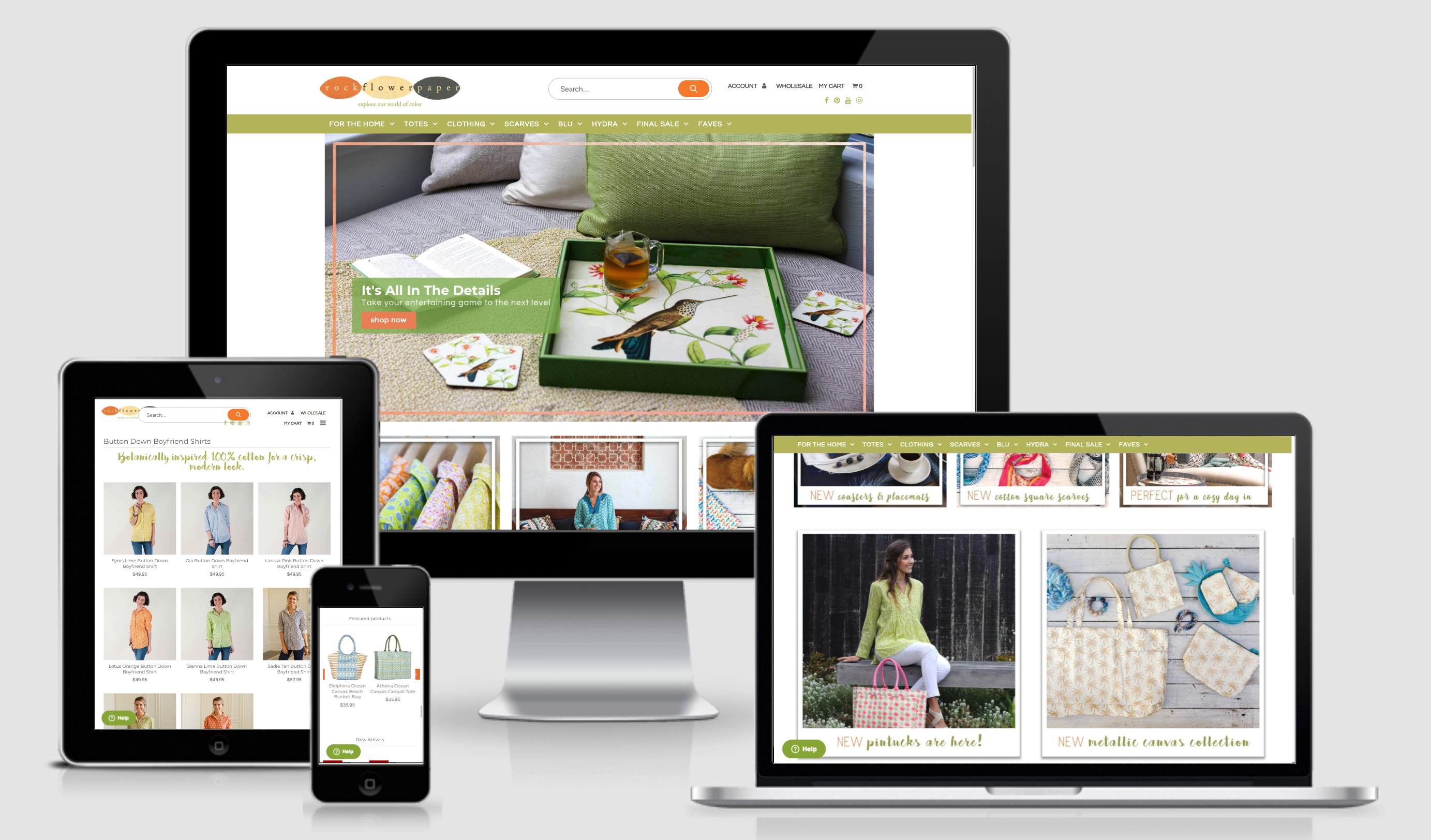- Since 2015, rockflowerpaper operated on Symphony Commerce, but it needed more from its ecommerce partner to scale
- After switching to Shopify, rockflowerpaper immediately saved more than $200,000 per year
- Conversion rates increased 30%, average order value jumped by $10, and its abandon cart rate dropped as much as 10%

“There’s no metric that is performing worse,” says Katie Smith, the company’s founder and owner. “We keep acquiring customers, and we keep growing our ecommerce business. We’re in a much healthier spot financially.”
It was 2017, and Katie Smith — then 58, a lifelong businesswoman, 35-year veteran of international trade, a company founder and owner — was stuck.
Nearly ten years had passed since she began her own business, rockflowerpaper, a California purveyor of bright, colorful clothing and accessories that had become a hit in the elite American coastal communities like Nantucket, near Cape Cod in Massachusetts, and Kiawah Island, off the shores of South Carolina.
rockflowerpaper products were available in 4,000 stores across the United States, mostly in high-net worth zip codes down each coast of the nation. Retail was winning.
But ecommerce was holding this company back.
In 2015, rockflowerpaper signed up with Symphony Commerce. It was no rushed decision.
Smith had labored over the choice, settling on Symphony because it could build her site quickly, but also because it offered what appeared as a competitive advantage. Symphony could handle the warehousing needed for her business, and it advertised competitive rates on freight, which was attractive to rockflowerpaper’s business.
It all seemed so good.
But as it scaled larger and larger, combined online revenue surging toward $2.5 million annually, its partnership was not built to last.
rockflowerpaper found itself looking elsewhere for help with its ecommerce experience.
‘There’s no metric that’s performing worse’
In 2017, Smith reached out to other companies like hers that were operating on Shopify. Waiting for her there was a migration process Smith and Matteo Tunioli, rockflowerpaper’s ecommerce manager, would later lay superlatives upon. “Onboarding was absolutely incredible,” says Tunioli.
Smith was thrilled that, upon joining Shopify, the platform was able to plug into her same warehousing operation, which she had grown to trust.

These were all well and good – a smooth replatforming, the creature comforts of a strong warehousing relationship brought along with them. But Smith had not reached this point in more than three decades in business without knowing it all mattered little unless the bottom line was improved.
It happened, even to her eyes, faster than she might’ve thought.
The metrics were striking. Over its lifetime on Shopify compared to Symphony, rockflowerpaper enjoyed on average …
- Savings of more than $200,000 per year
- A conversion rate bump of 31%
- Average order value expanding by up to $10
- An abandon cart rate that plummeted as much as 10%
- Visitor pages per session increasing 47%
- Page load time decreasing 28%
- A 9% drop in bounce rate
“There’s no metric that is performing worse,” Smith says. “We keep acquiring customers, and we keep growing our ecommerce business. We’re just in a much healthier spot financially.”

Tunioli has relished the tech support he now has. “There’s support now 24/7, whether that’s on chat or you calling,” he says. “I can be active right then and there. I can talk to a developer. There’s support research. There’s a much bigger knowledge base online for me to learn myself. You’d be surprised with how important that is for ecommerce operations.”
A backend that better supports this scaling business has afforded it a new perspective. Savings of more than $200,000 per year is nothing to sneeze at, and rockflowerpaper has grown by giving itself the boost it needed.
“It allows us to invest in our business,” says Smith. “It allows us to grow our ecommerce business to another level.”
‘Faster, less expensive, easier’
Removed from its ecommerce headaches, rockflowerpaper isn’t one to look back. There is so much more to do in this market, a loyal customer base to appease, higher planes to take this brand toward.
But there is no mistaking relief. With Shopify, Smith says rockflowerpaper’s ecommerce operations instantly became “faster, less expensive, easier.”
“We made the right decision,” says Tunioli. “We just wish we had made it sooner.”
Read more
- How Smoke Cartel Used Shopify Plus to Launch 24/7 Live Chat & Slash Customer Service Response Times 93%
- Digital Transformation: How YM Inc. Is Using Shopify Plus to Reimagine Its Retail Future … Online
- Why Marshawn Lynch Chose Shopify Plus to Power His Flagship Store Two Days Before Retiring from the NFL
- How Bohemia 4X’d Sales After Migrating & Supports the Survival of Artisan Crafts
- A “Golden” Opportunity: How Activewear Brand Rhone Disrupted Itself Two Years After Launching
- How a South Korean Entrepreneur Uses Homemade Cookies to Grow a Little Girl’s Fashion Brand 50% Every Month
- How a Seller of Outlandish Party Costumes Optimized Its Warehouse to Grow 400% & Compete With Amazon
- Ryonet Finds Ease and Speed for Both Its Online Wholesale Businesses
- ‘Localize, Don’t Internationalize’: How the U.K.'s Simba Hit $100M+ Going Global
Looking for a better way?
Thousands of high-growth, high-volume business have reduced costs and improved sales by switching to Shopify. If you’re ready to explore the future of commerce …


